“Hide your Moroccan flag until you get out of the city” tells me in Spanish a man passing by, as I am re-packing in Laayoune in the early morning before taking the road. I have a small Moroccan flag tied to my back pannier on the left side, in order to create a wider “safety distance” with cars and truck overtaking me on the road. It also makes me more visible, usually amuses some kids shouting “Marokko” when I pass by them, and tells me anytime how is the wind.
However, it is apparently not so welcome here in Western Sahara. The Moroccan flag is flown over all the administrative buildings, but the man tells me kids could throw stones at me if they see it. It is very possible that teenagers, the only annoying people in Morocco with faux guides, could do that, so I don’t put up the flag. From a big roundabout, the man shows me all the walls of buildings that have been repainted after the forbidden flag of Western Sahara was drawn on them.
This is how I start my day leaving quiet Laayoune around 7 am when my host goes to work. With the exception of Laayoune port, El Marsa, the next town on the road is Boujdour, 200 km away. I dream on reaching it this very same day, considered I am on the road early, if the wind blows in my favor.
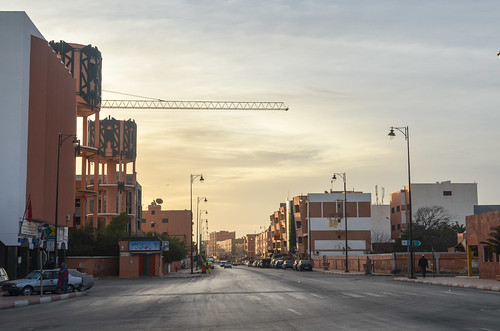

The wind is strong and helping me very well. I reach quickly El Marsa, the port of Laayoune. El Marsa is by the sea while Laayoune is by the oued, inland.
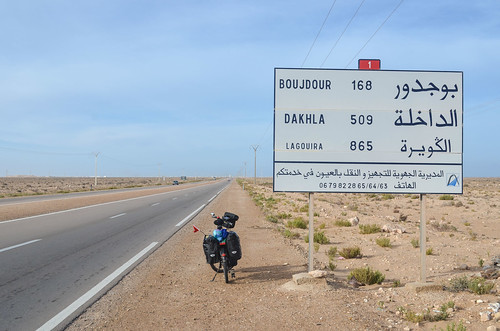
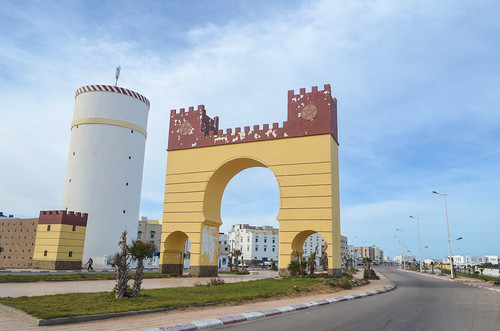
I enter the port of El Marsa after leaving my passport to the guards. There is no passenger connection to anywhere else, but seemingly a lot a goods imported and exported. For getting to the Canary Islands, the only option is to take a flight from Laayoune airport.
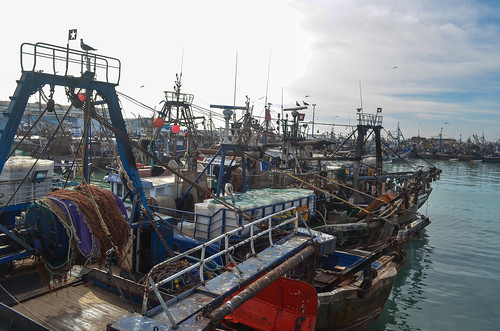
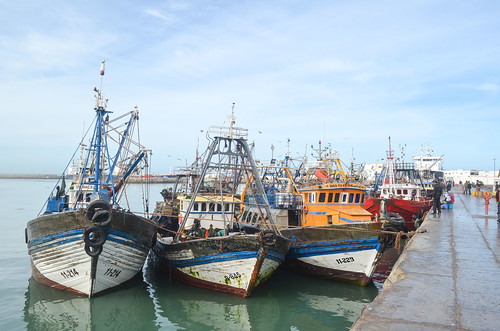
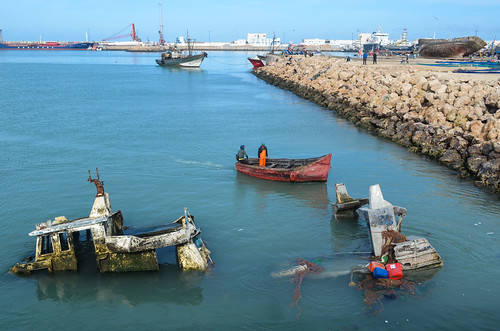
From the end of the breakwater, I can spot the terminal section of the longest conveyor belt system in the world. It is bringing the phosphate from the mine of Boukraa over 100 km in the desert until the port. The 2 million tons excavated annually are then exported to the USA and Europe. However, I was told that the mine employing 1600 people is in deficit. The mine is part of the largest company of Morocco and the world’s largest exporter of phosphates, the OCP. The Boukraa reserves are tiny in comparison with what OCP owns in Morocco. I will get to see this conveyor belt from closer when I cross it on my way south.

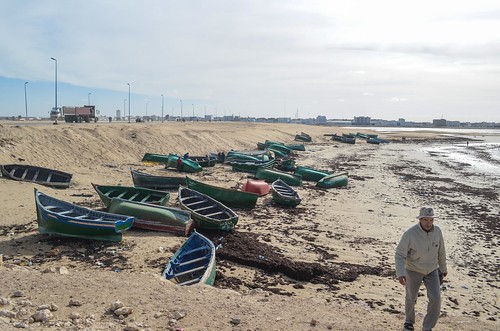
I leave the port almost in the same time with a wind turbine blade that just arrived. The truck is driving quite fast considering its atypical load and the many people roaming around in all transportation modes possible.

While getting my passport back at the entrance of the port, I ask the guard where did the blade go. “What?“. He didn’t see anything special. I wondered how the truck with a 50-meter blade handled the 90° turn and narrow gate, but the guard didn’t see anything. Apparently, he can spot a foreigner on a bicycle from far away, but not a wind turbine blade manoeuvring near him. I finally catch up with the truck and it overtakes me while going on the main road. There is a wind farm under construction just outside of El Marsa.
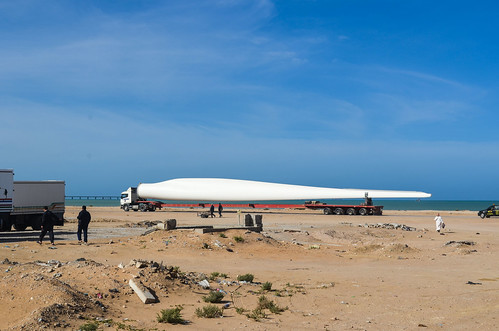
While stocking up food in El Marsa, I receive comments about the Moroccan flag flying on my bike. It goes from the usual “Yay Marokko!” to “Sahara! Sahara!” and “F*** you Marokko“. No stones thrown at me though, so I can leave for Boujdour, 160 km further, with my usual load of 5.5 L of water, and many breads.
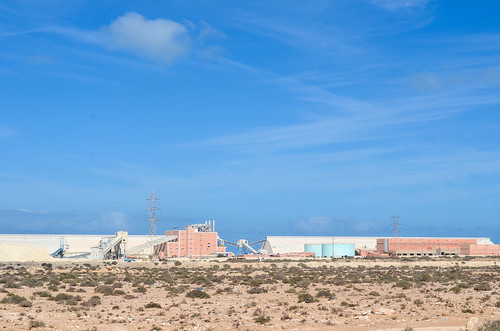
I pass on a small bridge over the world’s longest conveyor belt system. This is supposed to be the highlight of my day, but it is quite disappointing. The satellite pictures are much more impressive to capture its length over more than 100 km.
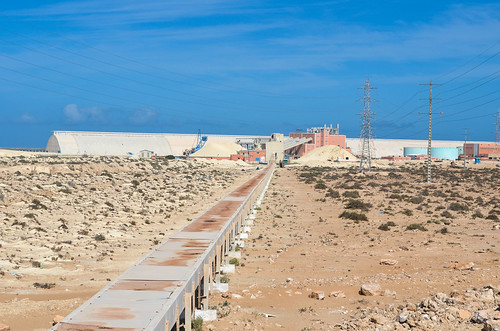
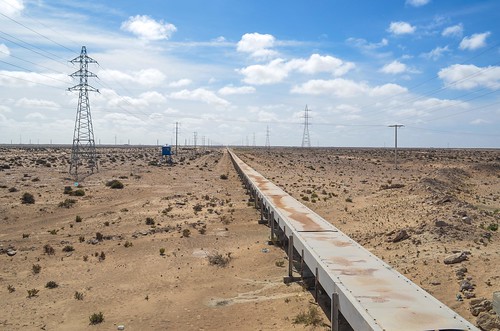
I benefit from a good tailwind and maintain a high speed for a while. It becomes realistic to complete 200 km today if I keep this rhythm. However I stop for picnic when the wind slightly changes to come from the side. I notice some asphalt under the sand 50 meters away from the road. Maybe older roads …
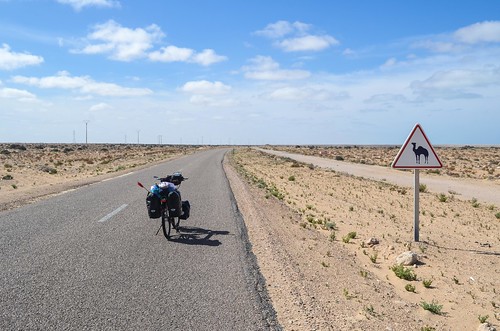

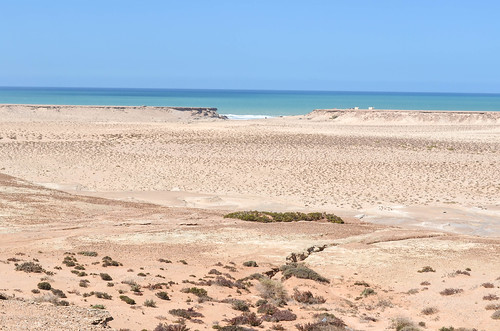

On the many kilometers of the road, watching ahead, or right, or left, I spot at some point a black smoke in the sky, like if coming from an oil well. Then it turns into a small castle in a lake. Then the mirage slowly disappears. It happens a few times during the day. It is funny as long as I know my position and have enough water with me …
The wind is back in my back and I reach Lamsid. This village has nothing more than one mosque, one gas station and a couple of buildings, but here again is perfectly halfway between El Marsa and Boujdour, limiting the longest distance without shops to under 100 km so far. And on the top of water and food, this shop has …. real cookies! I mean cookies with chocolate chips on top, unlike the Moroccan-manufactured cookies. They are the Dia cookies, my favorite substitute in Spain when the Chips Ahoy cookies were not available. It is the first time I see them in Morocco, alongside with other good chocolate and even marshmallows. Surprised by this considerate choice of imported goods in the desert, when they are not available in Morocco, the shopkeeper explains me that they enter through Ceuta and are driven through Morocco directly to Western Sahara. So the tax special treatment that benefits the province has good results for me too.
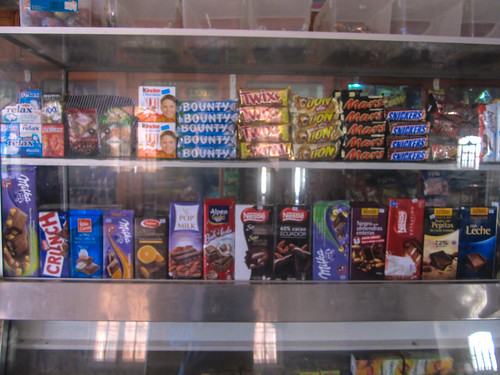

I still have 100 km to go if I want to reach Boujdour. The road can be indeed qualified as boring, but today I get the excitement of having the potential of a 200 km day. At 16:00, I still have 60 km to go. It was in Europe the time to start looking for a camp spot. Today, at the same time, I am confident that I can complete 60 more kilometers. I am finally taking my “revenge” one the wind and doing all the kilometers it prevented me to do earlier. My current record on a bicycle is 200 km, it was done on a mamachari in Hokkaido. I had almost no luggage but also only one gear.
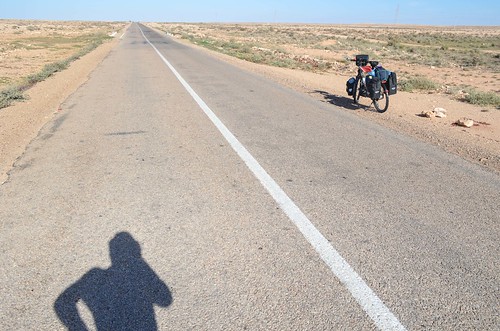
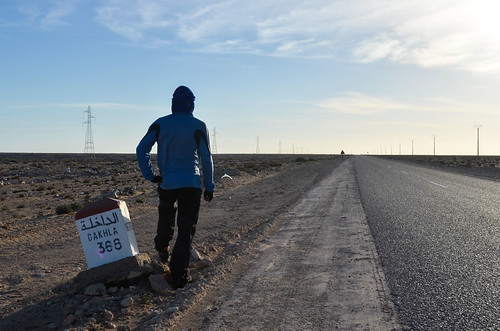
I enter Boujdour during the sunset, very satisfied that I managed the 200 km stretch (206 km in total) in one day and controlled my progress with confidence at almost any time. I am not especially tired, no more than some other days, and much less than the first 80-km-a-day headwind days.

The gate of Boujdour, really over sized compared to everything I have seen for the past hours, transforms the narrow 2×1 lane road (which lasted 150 km and with sides sometimes destroyed) into a 2×3 lanes road, brand new and with perfect surfacing. When I reach the proper town, 2 or 3 kilometers further, the road becomes “normal” again. This nonsense construction is usually the sign of a recent visit of the King, when the city must build something big and new, regardless of the usefulness.
The small city is, like the much smaller Tarfaya, either run down either in construction. Many people live in houses where bricks are not painted, and the last floors are left open. The center is however quite lively and has many restaurants. After finding the cheap hotel, I can hence turn into swallowing as much food as I did with kilometers. I had meat of camel, turkey, chicken and goat while in Laayoune. This time, I have for dinner a big plate of seafood. My desert is half a liter of milk with a half-baguette of camel meat. I think I really turned my body into a calorie burning machine.
I wake up and depart late, in the happy mood that I can cycle fast with the lasting strong wind from the north, but not over motivated by another long stretch of desert road.
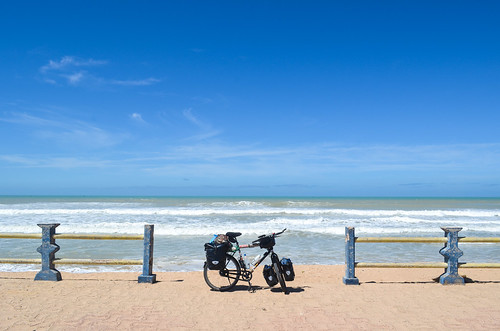
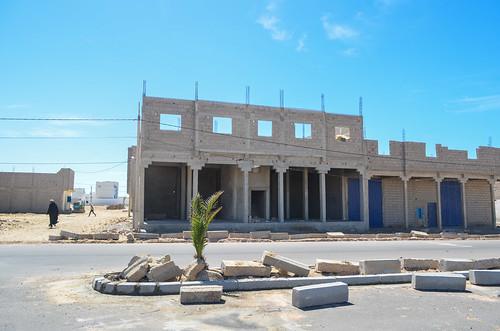
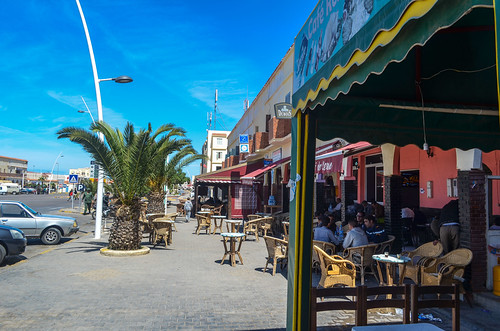
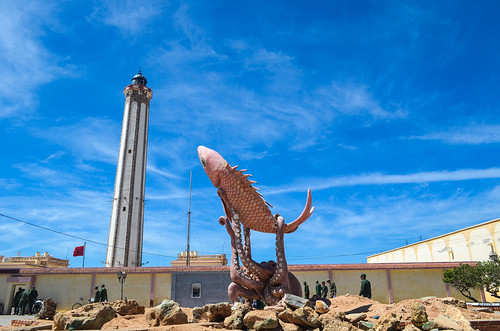
After breakfasting another half-baguette of camel meat, I set departure to Dakhla. That is apparently a 360 km stretch of nothing.


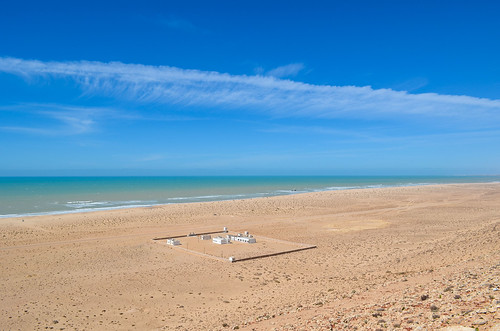
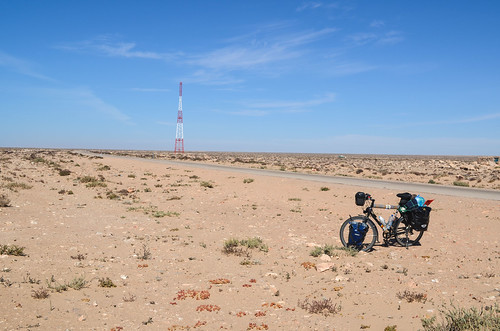
I have not much to say about cycling a straight road the whole day. I maintain for a while a nice average at 33 km/h. I see fishermen huts from time to time. I realize I am not using sun cream and that is a very good thing. That would be a pain to find here, and I would just use it too much. Covering the whole body instead is so much simpler. And no matter how much I tan, I will still look like a foreigner anyway.

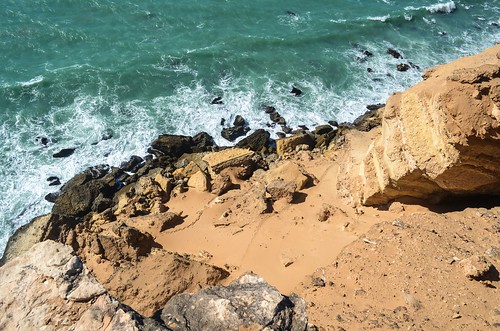
The cliff falling into the sea looks like the ocean is eating the coast little by little. This is now the longest distance without any shop or official water refill point, with 160 km between Boujdour and the first café.
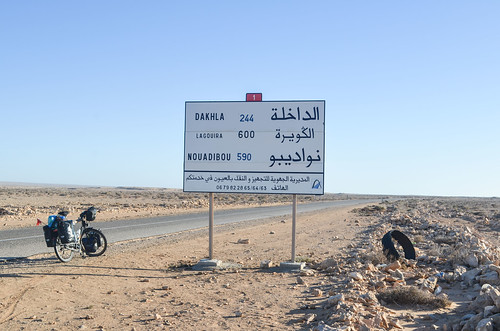
At 18:30, I am still contemplating doing a few more kilometers, until the sunset, and taking nice pictures. But a man with army clothes is waiting by the road and stops me. He orders me to sleep at the next cell tower. He brings into the story that Al-Qaeda, helped by the Polisario, is maybe around Western Sahara and I cannot camp freely. The man says to be a gendarme, but he has a different clothing from the previous ones. He has no ID, no badge, no number, no name on his standard army suit that I could find also in a souk, and is driving an old Peugeot car. He didn’t like the fact I said he could totally be one of those he warns me against. On the other hand, he has my name and phone number, which I gave earlier to the gendarmerie royale checkpoint, I don’t feel particularly unsafe in Western Sahara, and I expect to be tracked by the authorities. We agree to meet again at the next cell tower.
He is waiting there with the cell tower guard. He tells me I can must sleep inside. I know I cannot go against him and am abandoning the idea of camping in the wild under a wonderful sky of million stars.
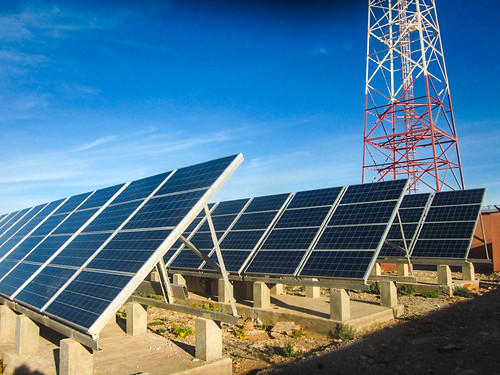
It seems all the cell towers of Morocco (often grouped by 3 for the 3 operators, Maroc Telecom/Etisalat, Meditel and Inwi) are man-guarded 24 hours a day. I don’t really know why, maybe to prevent the steel or solar panels to be stolen. Yahde is paid 200 € a month to be in the small room under the cell tower, in the middle of nowhere, 10 days on for 10 days off, while his family is in Laayoune. We prepare a tagine for dinner, that we eat with one of the fishermen living in a tent nearby for the fishing periods, exchange MP3’s, and fall asleep inside with the noise of the strong wind outside.

I am not allowed to climb the cell tower, so I still don’t know what could be the highlight of my day.

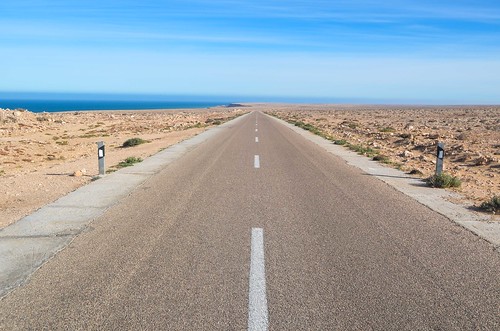

The day doesn’t start well. The tailwind has left me and it is now coming strongly from the east. This is actually slowing me down quite a lot.

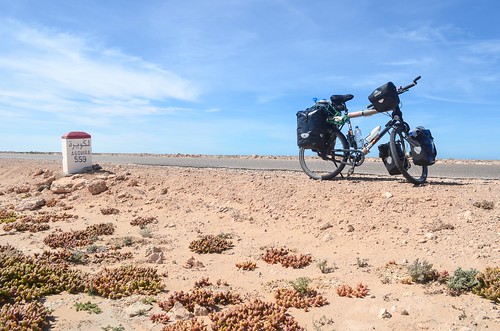
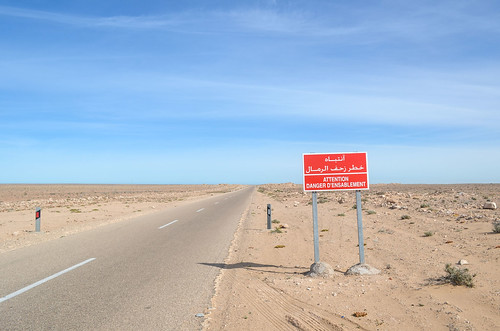
There are two cafés at KM 205 and KM 199 before Dakhla. I stop at both, and meet there again Adjudant Mohammed from yesterday. He is still watching my moves. He is telling me where I can sleep tonight, but we just agree to meet again 50 km further at his post, Oued Kraa or Oued Lakraa.
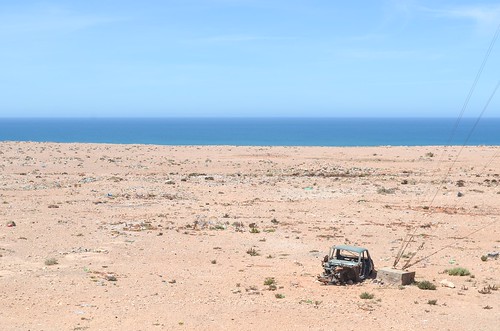
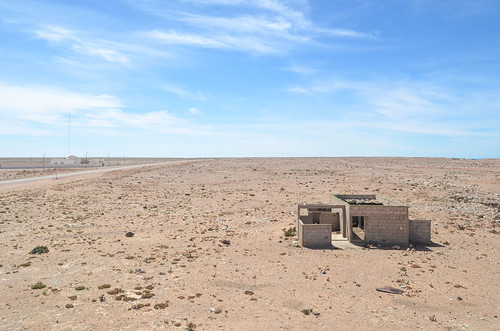
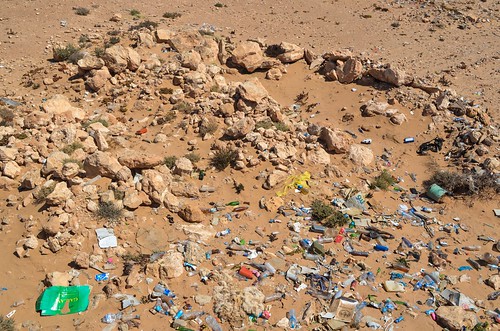
There is a crossroads at KM 199 before Dakhla going into the interior, with a sign reading “Forage Jeirida”. I am told it is a water well, drilled down to 1000 m, with thermal pools, bringing water for agriculture and camels. I would pay it a visit if it was not 44 km one-way. One truck driver proudly shows the 2 beers he bought at the café (of course not supposed to sell them), and reminds me that I must be vigilant at all times on this single road.

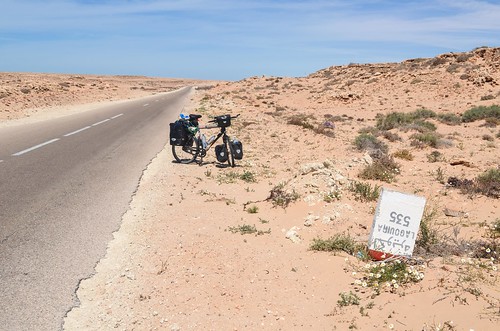
I still enjoy the road. It is indeed long, but has enough turns and little “goodies” like a milestone upside down or a short stretch into mini canyons to entertain me.

I stop at the petrol station of Oued Kraa for a tagine. The same gendarme is here again. He gives me the phone number of the gendarme responsible for the next area, as his is ending here.
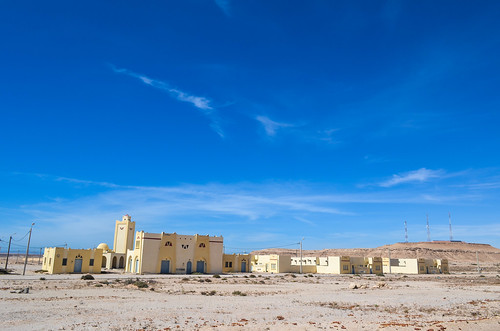
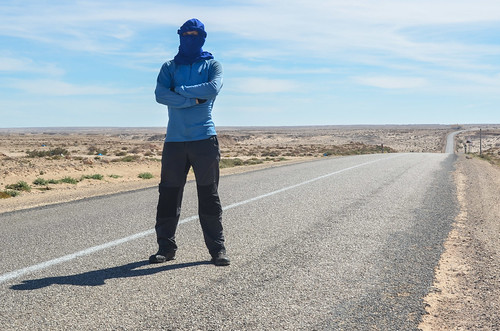


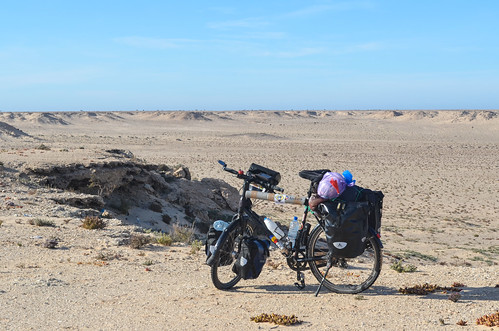
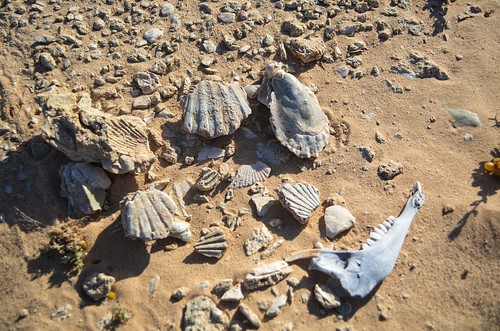
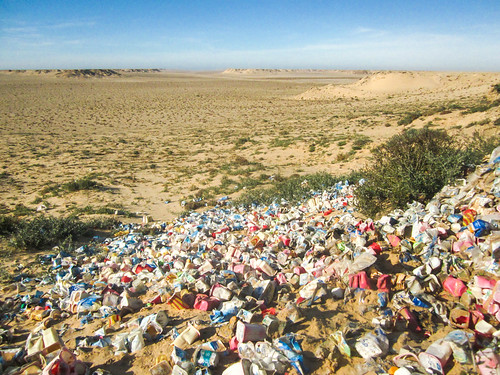

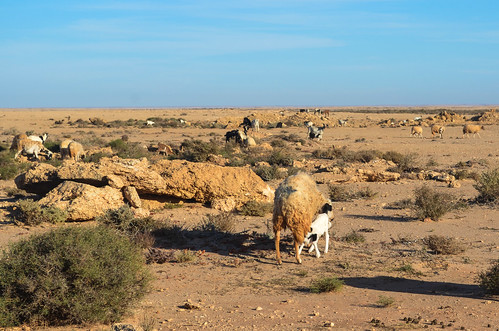
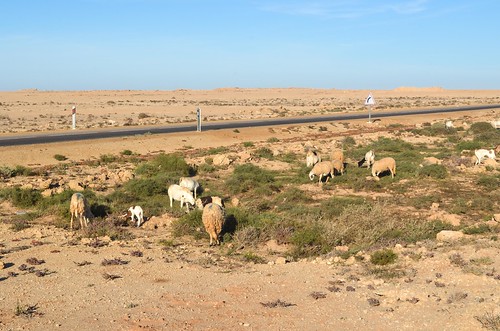
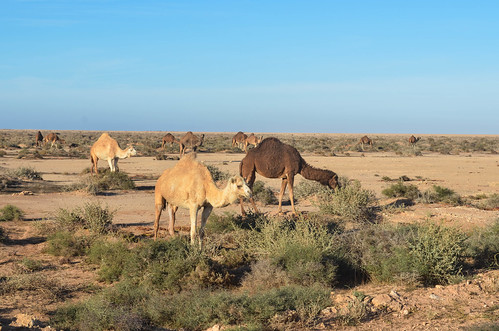
I reach the commune rurale Biz Anrazane with still one hour of daylight and a good tailwind, but it is where the gendarme has somehow planned my stop. Bir Anzarane is a small town further inside the desert, but a new town with the same name is being built by the N1 road. There are new lights never used, a new road never used … it makes me think of empty communist structures built only to impress.
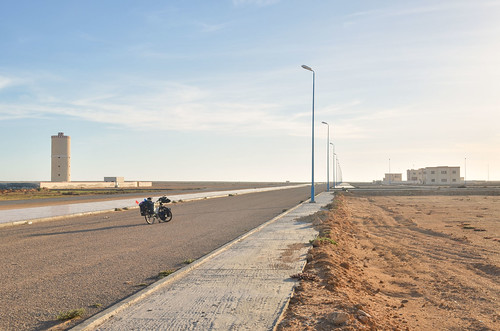
As I pass in front of one of those brand new never used buildings, I am called in by two men. They are Marfoud, the guard of the place, and Said, the construction site manager in charge of more brand new useless building behind the one we are sitting in. Said is from Tilmi, a place that I have been cycling through: the first village (with the most annoying kids of Morocco) after the piste from Agoudal down through the Dadès valley.

They are both extremely welcoming, and Marfoud’s repeating “Marhaba, bienvenue” every single minute makes me quit the idea of doing the 30 kilometers I could do until sunset, on the top of 110 made already. They also quickly make plans for me to shower and sleep. From here to Dakhla, I am left with 120 km for tomorrow, so Centre Bir Anzarane actually makes a good stop. The extreme cheerfulness of those two men is supported by the bad alcohol bottle they are drinking while smoking.
I have to escape from them for a few minutes to make some videos of the sunset before they show me the shower.
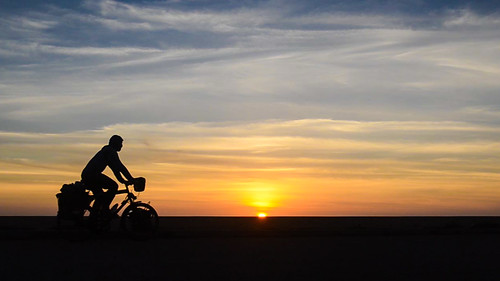
I was already surprised that they mentioned “hot shower” in such a place where there is no electricity. It becomes more realistic when Marfoud says, pointing at big pipes and the road and the unused water tower: “hmmm… the shower is broken, you see the pipes, there is a problem …“. If the construction manager is drunk during the day, I am not surprised the brand new installations are already broken.
Yet, after Marfoud performs a quick test on me, “Who are the 2 mens on the wall posters?” (Messi and Ronaldo of course, there is no other poster here except the fake chinese photoshopped posters of nature with lions and cows), we get ready for my shower: they prepare the big bucket, the small bucket, the soap, the shampoo, and the big adjustable wrench.
A wrench for the shower? I didn’t understand until I got to the small building at the end of the grass field. This is in a way the “machine room” of the well, 980 m underground, bringing hot water to the surface. Said opens the “tap” with the wrench and I am left alone in the room with very hot water smelling sulfur. For me who love hot springs and rotenburos, having my private drill is a wonderful and special treat. Moreover, a Sahara hot spring …
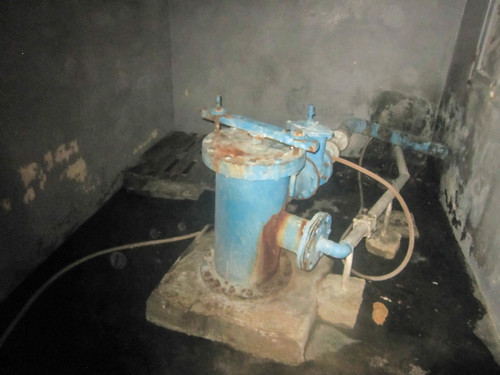
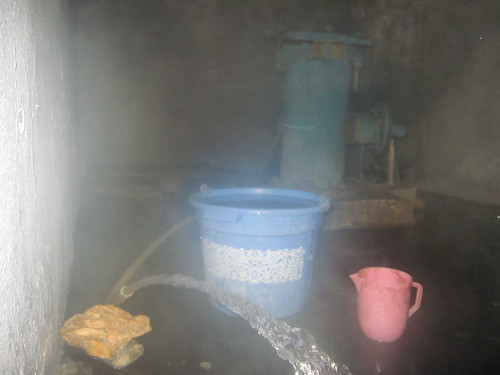
I dry outside under the wonderful sky and stars.
I am still carrying a small bottle of home made eau-de-vie of dates, that I have alongside with cigarettes to trade against water or food if needed in the desert. Visibly water and food is available everyday, so I could share my eau-de-vie, but sadly it seems that the only Moroccans who drink alcohol are alcoholics.
We are joined for dinner by a group of Sahrawis, arguing together whether Western Sahara belongs to Morocco or not, for an interesting but tense evening.
We have breakfast together before I leave for my last stretch of 120 km before Dakhla. The wind is good and I am looking forward to reach this mental milestone, and take some days of rest.
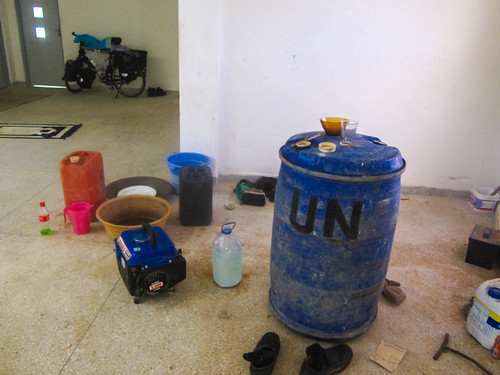
The cliffs into the ocean are still very steep and the Sahara sometimes falls into it.
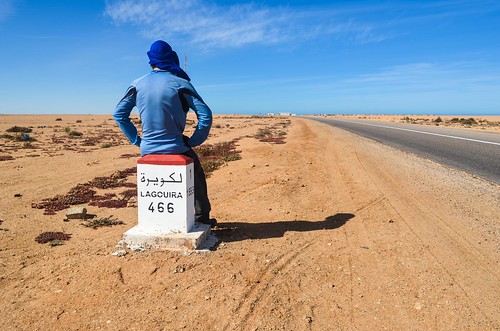



Before reaching Dakhla, I cross another settlement: the fisherman village of Ntirift. It looks like another ghost town from the road: empty brand new houses falling already into despair, and a grid of electric lines without anything to supply with energy.

Ntirift has actually many fishermen, but they are all living in tents and huts right by the coast. I explore this ghost new town when I see a man fetching water from a manhole on an empty plot. He is the guard of the school and invites me over for a tea, that turns into a light lunch. He is guarding an empty school. It was built 3 or 4 years ago and is still not welcoming any kids. He is saying that maybe in a couple of more years, the new town will be inhabited … but all I see for now, and it’s not the first time, is a waste of money: brand new empty houses being destroyed by the weather and the lack of maintenance, near people living in shacks and tents.
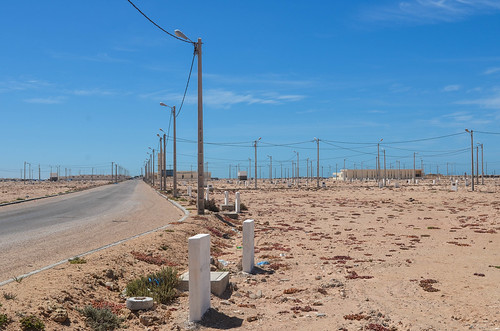
He is also telling me about the fishing in the area. The fishes of the coast here are of very good quality, hence expensive. There are more Moroccan fishermen than Sahrawis, and all their catches are exported to the north of the country. It’s right that I’ve seen a lot of refrigerated containers on trucks heading north. I have heard that Morocco labels some products from Agadir to avoid the international boycott of Western Sahara. He’s, like many, angry about Morocco’s policies, but for now accepts being paid for guarding an empty building in a ghost town.
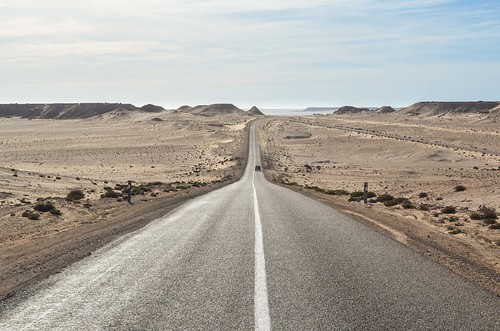
Around 17:00, I reach a roundabout called Quarante, because it is 40 kilometers before Dakhla. From here, I must leave the main road and cycle this distance on a peninsula, at the end of which lays the city of Dakhla and its 50’000 inhabitants. I will have to cycle back those 40 km later.

I have 10 kilometers of crosswind before I head south again, at Vingt-Huit and Vingt-Cinq. Those are spots for kite-surfing, as Dakhla is one of the most famous location for it. The waters between the peninsula and the main land are shallow and quiet, but enjoying a very strong wind from the north, allowing the kite-surfers to join the two sides. There is an international competition later in March.

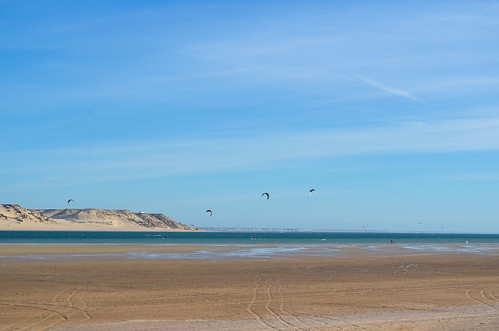
The city is preceded by the airport, a very long army fort, and cherry tomato farms. Those are very expensive and for export only. I am welcomed in the city by Ali, a friend of Hassan from Tighmi met after leaving Tafraoute 1200 km ago. I rest here 3 days during which Ali demonstrates an extreme kindness and hospitality.
Almost everything in Dakhla costs 1 or 2 dirhams more than in northern Morocco. My Milka chocolate tablet price jumps from 13 dh to 25 dh. Like Saharan cities, the streets are deserted during the day. Most of the shops are closed and the people hidden. Slowly, from 16:00, the street vendors install their tarps on the floor. The shops open, and by the time lights are switched on for the night, the streets are filled with people. It is extremely lively from 18:00 until midnight where all kinds of shops are open and food available. I eat a lot of the delicious courbine, the most popular local fish, and go for a beach football game and swim with Ali’s friends.
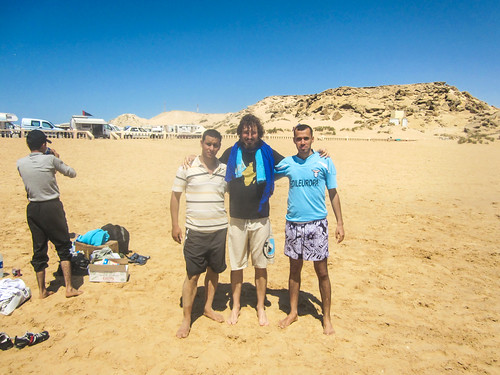
The only downside is the presence of flies everywhere, in cafés, houses and even while cycling. Speaking of cafés, I was in one of them where people watch a football game of Monaco, the french Ligue 2. Really, any football game is watched here …
Dakhla is the southernmost “big” town of Morocco. Actually, half of the Moroccan land, where everyone lives, is north of Tiznit, which is 1000 km away. Dakhla is perfectly in the middle of the desert, as the Sahara continues until the south of Mauritania, another 1000 km further. I quite enjoyed the first 1000 km of desert so far, I hope it lasts!






I am always amazed about these incredible, beautiful Bike Blogs. I am here by coincidence and will read all the posts in the next month.
The community is Great! Thank you so much for your work.
Heading to Dakhla in 3 weeks on my bike.
So happy that I was directed here
Found your blog when looking for info on the El Marsa gate. I was on a small ship cruise from Malaga to Cape Town. We made port in Laayoune and Dakhla. My late husband and I biked the Camino de Santiago twice, in 2001 and 2003. I loved reading your blog. Thanks for posting it. Best wishes. jean
Hi Jean, thank you for your comment
A cruise all the day down the west coast, it must have been interesting!